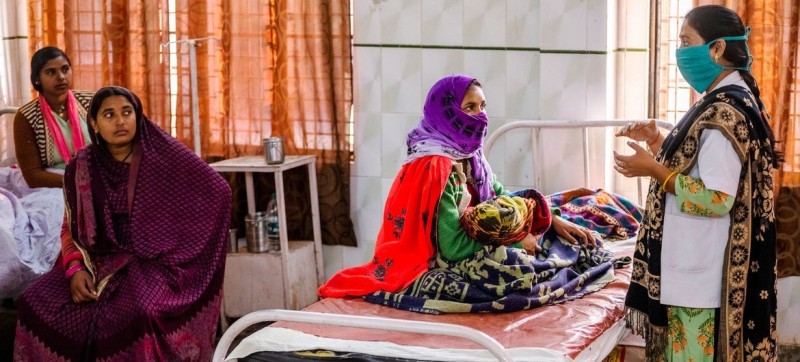Contents
© UNICEF/Prashanth Vishwanathan A nurse interacts with a mother at a pre-natal care ward of Combined District Hospital in Chitrakoot, India.
“It is welcome news that health systems in the majority of countries are starting to restore essential health services for millions of people who missed them during the pandemic,” said Dr. Rudi Eggers, director for integrated health services at the World Health Organization (WHO).
Tweet URL
“But, we need to ensure that all countries continue to close this gap to recover health services, and apply lessons learnt to build more prepared and resilient health systems for the future”.
Recovery, resilience investments
By early 2023, countries reported experiencing reduced disruptions in the delivery of routine health services, but highlighted the need to invest in recovery and stronger resilience for the future, the UN health agency said in its newly published interim report “Fourth round of the global pulse survey on continuity of essential health services during the COVID-19 pandemic: November 2022–January 2023”.
Among the 139 countries responding to the survey, WHO said continued disruptions persist in almost one quarter of services. In 84 countries where trend analysis is possible, the percentage of disrupted services declined on average from 56 per cent in July to September 2020 to 23 per cent in November 2022, to January 2023.
Respondents also expressed a need for WHO support to address remaining challenges in the COVID-19 context and beyond. This pertains most frequently to strengthening the health workforce, building monitoring capacities of health services, and designing primary healthcare.
Towards pre-pandemic standards
By the end of 2022, most countries reported partial signs of service recovery. This included services for sexual, reproductive, maternal, newborn, child, and adolescent health; nutrition; immunization; and communicable diseases (including malaria, HIV, and other sexually-transmitted infections).
In the new survey, fewer countries reported intentionally scaling back access across all service delivery platforms and essential public health functions since the 2020 to 2021 period. This demonstrates an important step to return to pre-pandemic levels of service delivery and broader system functioning, WHO said.
In addition, the number of countries reporting disruption to their national supply chain system reduced from nearly half (29 of 59 responding countries) to about a quarter (18 of 66 responding countries) within the last year.

© UNICEF/Thoko Chikondi A health worker prepares to administer COVID-19 vaccines at a village in Kasungu, Malawi.
Tackling backlogs, service disruption
Despite signs of recovery, service disruptions persist across countries in all regions and income levels, and across most service delivery settings and tracer service areas, WHO said.
Demand and supply factors are fuelling this trend, causing persistent disruptions, from low levels of healthcare-seeking in communities, to the limited availability of workers and such related resources as open clinics or available stocks of medicines and products.
Countries are also dealing with increasing service backlogs – often in services for screening, diagnosis, and treatment of non-communicable diseases – which can lead to negative consequences as people are denied access to timely care.
Progress in integrating COVID-19 services
Recovering essential health service delivery is critical, WHO said. Disruptions to such services as health promotion, disease prevention, diagnosis, treatment, rehabilitation, and palliation may have even greater adverse health effects than the pandemic itself, especially among vulnerable populations, the health agency added.
In another important step towards system recovery and transition, WHO reported that most countries have made progress in integrating COVID-19 services into routine health service delivery. About 80 to 90 per cent of countries have fully integrated COVID-19 vaccination, diagnostic, and case management services as well as services for post COVID-19 conditions such as ‘long COVID’, into routine service delivery.
Applying lessons learned
Still, 80 per cent of 83 responding countries reported at least one bottleneck to scaling up access to essential COVID-19 tools, from diagnostics, therapeutics to personal protective equipment. Other common barriers are health workforce issues and lack of funding.
At the same time, most countries have started to apply lessons learned during the pandemic, including through the institutionalization of several innovative service disruption mitigation strategies into routine service delivery.
These include deployment of telemedicine approaches, promotion of home-based care or self-care interventions, approaches for strengthening health workers availability, capacities and support mechanisms, innovations in procuring and delivering medicines and supplies, more routine community communications, and partnerships with private sector providers.
In the same vein, three quarters of countries reported additional funding allocation towards longer term system recovery, resilience, and preparedness.
Tracking progress
In the fourth round of WHO’s global pulse survey, 222 countries, territories and areas were invited to respond to a standardized web-based survey between November 2022 and January 2023.
The survey followed up on WHO’s previous 2020 and 2021 editions: Round 1 (May-September 2020); Round 2 (January-March 2021); and Round 3 (November-December 2021) which showed the extent to which the pandemic was affecting the continuity of essential health services and how countries are taking action.
Learn more about the UN response to the COVID-19 pandemic here.




Comments are closed, but trackbacks and pingbacks are open.